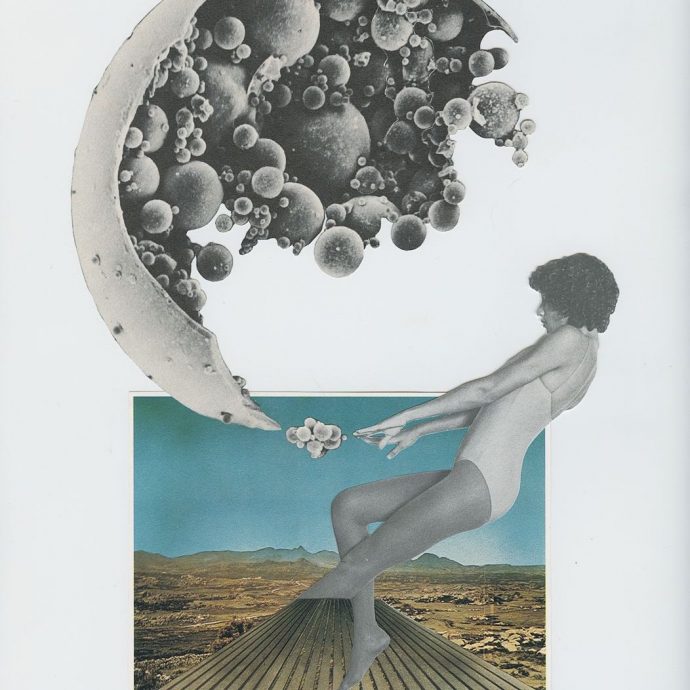In the Mahabaratha, Draupadi is a depicted as a lovely woman with glowing dark skin, long black hair, and the scented fragrance of lotus. Draupadi is famed for her ferocity and strength. She does not hesitate to speak her mind in a world dominated by men.
Yet her fate is largely defined by men—perhaps unsurprising in an epic written by a man, the sage Vyasa. Draupadi is married off to five men, the Pandavas. Yudhishthira, the eldest Pandava brother, is tricked into gambling away everything he owns—his wealth and his kingdom—to his cousins, the Kauravas. Left with nothing, he gambles away each of his brothers. Then himself. Finally, his wife, Draupadi.
In one of the most defining moments of the epic, Draupadi is forcefully dragged into the chambers by her hair. She is menstruating and wearing only a single piece of cloth: the sari. One of the Kaurava brothers, Dushasana, tries to strip Draupadi naked by pulling at her sari to unravel it. As she is humiliated, the elders in court sit by silently, as do her husbands.
Left with no recourse, Draupadi prays to Lord Krishna. He answers, using his powers to extend her sari infinitely. As Dushasana attempts to unwrap layers of her sari, it keeps getting longer and longer. Ultimately, Dushasana’s efforts to disrobe her are defeated by a sari.
I grew up hearing about Draupadi’s story and the humiliation that befell her. In her tale, the sari offers safety—an armor that shields her from harm. But I experienced the sari very differently.
Every August, I travel home to perform puja with Amma, my mother, for Varalaxmi Vratam, a festival perhaps more important in our Andhra family than Diwali. On this day, our suburban New Jersey home transforms into our homeland. Bright flowers and mango leaves adorn our front door. Early in the morning, Amma carefully creates the Goddess Lakshmi, filling a silver pot with rice and placing upon it a coconut plastered yellow in turmeric. Amma laces gold jewelry and a homemade garland of rose petals around the goddess’s neck, then wraps a cloth around as her sari.
Sitting cross-legged, I fashion the elephant-headed Ganesha, destroyer of obstacles, out of turmeric and water. I gather lilies and marigolds from our garden to spread around the idols. Afterwards, I follow along as my mom conducts the puja, first chanting, then retelling a Hindu myth. Then comes my favorite part—the taste of prasad: rice pudding (payasam) and small round laddoos, blessed by God.
This year, I’ve turned thirty. I vow to myself: this time, I will tie my own sari. I browse YouTube, amazed to find hundreds of ways to drape a sari, each specific to a region and heritage. I’m mesmerized by the diversity of the garment.
Surely, I can figure out one way of draping it.
Yet, when morning arrives, I find myself drowning in the layers of cloth, not knowing where to begin pleating, how to tuck the sari in so it grazes the floor, or how to arrange the pallu over my shoulders. I can’t manipulate the cloth deftly while securing it with an errant safety pin.
My mother knocks and enters.
“Shall I help?” she asks. I drop the yards of fabric to the floor, my hands raised in surrender.
She takes control, her fingers flitting with the ease of an expert. When the sari is tied, it looks prim and proper. But inside, I feel constricted by its seemingly infinite loops.
At what age will I be too old to seek my mother’s help with the heavy things? With performing Hindu rituals? With cooking South Indian food for guests? As I turn thirty, it seems the time has come for me to take on that mantle, but I feel as much a child as ever.
To this day, the need to don a sari strikes in me an irrational fear.
For me, the sari has long represented an unrealistic feminine Indian ideal. A woman wearing a sari is a perfect wife, a mother; traditional, yet independent; elegant, yet strong. She can readily whip up dahi vada or masala dosa, and when relatives visit, she immediately brings over a cup of masala chai and cookies. She knows how to perform pujas and chant all the right mantras. From engagements to festivals like Vinayaka Chavithi, she can break out into song with a repertoire of Bollywood or classic Carnatic songs under her belt.
Even when women in my community achieve professional success, they’re judged by how well they continue to adhere to traditions. I grew up hearing about one of my aunts, who, after moving to the US for a teaching job, became a legend for wearing a sari to class every day as a university professor. Here was the perfect woman to mimic.
That was unthinkable for me, a young girl who’d moved from India to the U.S., a new immigrant in the hallways of a new school. Wearing Indian clothes would only make me a further target of ridicule.
But as I grew older, not being able to tie my own sari began to feel like a hindrance. In so many ways, I was far from the quintessential Indian woman my family expected: not a student of engineering or medicine, but of law and feminism. Not on track to be a mother before thirty, but a traveler without roots. Not able to conjure up a flawless plate of idli for breakfast, but resigned to baking banana bread. To top it all off, my lack of comfort with the sari tapped into a deep insecurity, leaving me feeling like even more of a disappointment to my culture.
Something was left behind, even as much was gained, growing up in the United States.
The sari, one of the world’s oldest forms of clothing, has been in existence for more than 5,000 years. It is mentioned in the Vedas and in records from the ancient Indus Valley civilization. But it has endured as a fashion statement and a practical dress because of its versatility.
My grandmother’s almirah, her wardrobe, contained dozens of saris collected over the years, stacked and folded neatly into squares. As a young girl, I spent many summers attached at the hip with her, my ammamma, in our family home in Hyderabad, and every morning I’d watch as she draped her sari. She’d hold the garment in place on her shoulder, twirling around in languid circles until the cloth fell into place effortlessly.
While she napped, I peeked through her collection, touching the multicolored silk and cotton fabrics, my fingers lingering over those that were especially shiny or luxurious. Daily, Ammamma wore the simplest cotton saris for cooking and cleaning until they were softened, like the pillowy skin of Ammamma’s own face. Then, there were the cotton saris starched and ironed for a special moment, like a visit to the temple. Yet others were precious silk, countless types—pochampally, narayanpet, banarasi, kanchipuram, mysore—hailing from towns across India. These were reserved for weddings, pujas, and social gatherings.
As my mother once remarked, the sari is forever. You wear a sari as you age, gain weight, become pregnant, or thin out. As your hair grows grey, as your children have children. Saris mold to whatever shape and size you are. And they make the perfect heirlooms, passed down across generations. Saris are meant to last lifetimes.
Growing up as a teenager in New Jersey, the weddings I saw on TV or in magazines seemed breezy and intimate. They took place in lush gardens or on the beach, with a teary couple sharing vows and a heartfelt kiss. I’d spend weekends snipping photos from bridal magazines and watching one too many episodes of Say Yes to the Dress. I’d fully bought into the dream they were selling. I fantasized about walking down the aisle in a white dress, like Carrie Bradshaw’s iconic Vivienne Westwood wedding gown in Sex & the City.
Years later, I found myself waking up before sunrise on my own wedding day. I was no longer a naïve teen who thought a flouncy white dress would transport me to the land of happily ever after; I was set to marry my Indian-American fiancé because we were perfectly matched, supporting each other’s sometimes farfetched dreams and deepest aspirations. I was to wear a traditional silk sari from Hyderabad—orange and pink, with gold zari work lining the border.
In the darkness, my makeup artist draped my sari with speed and unparalleled precision. By the time the final pleat was in place, the sun was up. I glanced in the mirror and saw a flawlessly arranged Indian doll. And I felt like one too; a false construction, presenting me as someone I wasn’t.
I might have outgrown my childish dreams, but I couldn’t help but think about how my dress wasn’t flowy or romantic; it was stiff, ironed, and pleated. As I walked down the aisle in my wedding sari, adorned with gold jewelry and a coconut in my hennaed hands, I was the outward embodiment of a perfect Indian bride. But inside, I felt a disconnect with the garment I was wearing. I didn’t need the sickly sweet sentiment I’d watched on TV as a kid, but I still resented the loss of romance.
I was marrying the person I loved most. Yet, I was dressed like someone I barely recognized.
When I look for feminists in the Hindu canon, I always turn to Kali, the blue-skinned deity who is the most potent incarnation of Lord Shiva’s wife. Kali destroys evil and protects good—and she’s often painted with red eyes wide open, fangs protruding from her mouth, and her tongue hanging out. She looks ferocious, her mouth red with the blood of demons.
Sometimes, Kali is shown with her foot on Shiva’s chest as the God lies on the ground. In this moment, Kali is spiraling out of control. She is about to destroy the entire universe. To calm her, Shiva lies beneath her feet in a subversion of typical gender norms. Kali is the embodiment of anger—and her powerful husband soothes her, prostrate and submissive.
Of all the goddesses, Kali doesn’t wear a sari. Instead, she goes topless, her only covering a garland of severed human heads and a skirt made of human arms.
To be powerful like Kali, one could not also be the idealized Indian woman—the lovely one who dons a sari.
The women in my family are strong, outspoken, the backbone of their households. They have gotten graduate degrees and become teachers, doctors, and engineers. After crossing continents to set foot in the U.S., my mother set her sights on moving to New Jersey for a shot at a career in technology. She commuted to New York every day, all the while raising me.
These women have no qualms about expressing anger, displeasure, or disappointment to their husbands. They yell, chastise, or give their husbands the cold shoulder. And the men listen—because the ladies are the undisputed commanders of the family.
Yet, as mothers, they invariably impose on their daughters the same toxic ideas they were taught: the importance of finding a husband (preferably a doctor or an engineer) of the same religion and caste. They teach their daughters to cook meals and serve the men who come over for pujas and dinner parties. They tell their daughters that education and a career is a baseline, but all of that is for naught if they don’t have a husband, a house, a baby by thirty. And they show their daughters how to tie a sari perfectly.
I was not that daughter. I was the daughter who traveled to Sierra Leone, Afghanistan, and Bangladesh alone. I was the daughter who worked on the unmentionable: sexual violence and “revenge porn.” I was the daughter who picked up and left her new husband to live for months in Nepal, working with a human rights organization. I was the daughter who helped clients in abusive relationships get divorced—a taboo in many Indian households.
Yet, when I came home, I transformed into a compliant daughter. I talked about the Instant Pot and the Vitamix, Whatsapped my mother photos of my meals, and exchanged recipes with her. Yet, I still felt that I had failed my mother many times over.
If you peeled back the layers of our mothers’ saris, what would you see?
Beneath the vibrant dress and confident smiles were, ultimately, the rules of a world dominated by men. Our mothers were unknowing pawns.
I, too, have layers like my mother. In “American” spaces, I am a writer, a feminist, a gender justice advocate, a traveler. At home, I am a dutiful daughter, a married woman, a sous chef.
As a child, the ways in which Draupadi was so publicly sexualized and shamed shocked me. But as an adult, I see that the story is not just about an abused woman, but an empowered one. Standing in that hall, Draupadi unleashes her fury on the men who enabled her abuse.
After the failure to strip Draupadi, Duryodhana—the eldest Kaurava brother—asks Draupadi to sit on his lap, believing he owned her. In response, Draupadi curses Duryodhana to death and vows to wash her hair with Dushasana’s blood. Her prophecies later come true, with the Kaurava brothers suffering a terrible fate.
Draupadi also reproaches the elders in court. How could they have watched Dushasana’s attempt to violate her and sit by silently? As bystanders who had failed to act, they, too, were complicit in the abuse.
Draupadi’s sari is a source of potential humiliation. But through divine intervention, the sari’s endless layers transform into protection against male oppression. The sari gives Draupadi the courage and the space to call out the wrongs done to her.
A few years ago in law school, I researched how, in the absence of justice systems that properly address gender-based violence, women find alternative ways to resist.
My research led me to the Gulabi Gang—the Pink Saris—a vigilante group in Uttar Pradesh formed by Sampat Pal Devi. In the 1980s, Devi first used a lathi, or a stick, against a neighbor abusing his wife—successfully defending her from harm. After, she trained other women to frighten abusive men with lathis—destroying evil, protecting good. Today, her movement includes more than 400,000 women across 11 districts of Uttar Pradesh. Dressed in pink saris, the women come together to intimidate abusive husbands, police, and corrupt local officials and prevent violence against women, corruption, child marriage, and forced marriage. “We are not a gang in the usual sense of the term,” says Devi. “We are a gang for justice.” Like Draupadi, they use their voices and their power to rebuke the men who oppress women.
The Gulabi Gang disrupts my notions of the sari. Here are thousands of women banding together to speak the language of violence while wearing the feminine pink sari. Their collective mobilization, their wielding of lathis, transforms the sari into a symbol of power.
Perhaps my ideas of what a sari means is too narrow. Perhaps it can be redefined by those who push past its boundaries—by women like the Gulabi Gang.
After all, a woman can be anything: beautiful, loving, devoted, angry, destructive. Fearless, like Draupadi. A force for good, yet unconventional, like Kali.
A sari does not change that; ultimately, it is only a piece of cloth. It is the woman, within, who must reveal herself.
Akhila Kolisetty is a writer, lawyer, and feminist policy advocate in New York. Her essays and poetry have been published in Catapult, Lit Hub, The Rumpus, Lunch Ticket, The Offing, Entropy, Sky Island Journal, Rigorous Magazine, and elsewhere.




